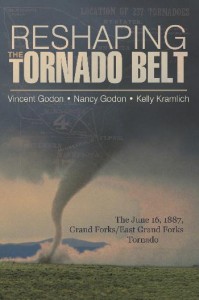 Most people have not heard the term Tornado Belt, but may have heard of Tornado Alley. Both terms are interchangeable, but the descriptor Tornado Belt came first, originating in the 1880s. The 1880s were a period of explosive growth in the nation’s midsection, as thousands of settlers poured in to settle the vast prairie states. Communication systems, like the telegraph and telephone, were slowly connecting the northern plains with the main population centers in the East. These systems made the United States smaller, broadcasting news from the frontier to all the media markets in the East and West. The science of meteorology and the understanding of tornadoes were also in their infancy. However, these newer communication methods also benefitted meteorologists. Details of tornadoes from all over the country poured into the Signal Service Headquarters in Washington, D. C. Early tornado research was assigned to John Park Finley, who jumped head first into this strange new topic. Finley compiled lists of all the tornadoes that occurred, past and present, and wrote papers on what he found. One thing his research determined was that there was a northern limit to where tornadoes occurred. Although Finley had many years of data for the eastern United States, his data over the northern plains was very limited. Not knowing any better at the time, people took Finley’s early data as fact. Communities like Grand Forks and East Grand Forks proudly proclaimed their towns as outside the Tornado Belt. They stated they could handle a little cold winter weather if they did not have to deal with the death and destruction caused by tornadoes!
Most people have not heard the term Tornado Belt, but may have heard of Tornado Alley. Both terms are interchangeable, but the descriptor Tornado Belt came first, originating in the 1880s. The 1880s were a period of explosive growth in the nation’s midsection, as thousands of settlers poured in to settle the vast prairie states. Communication systems, like the telegraph and telephone, were slowly connecting the northern plains with the main population centers in the East. These systems made the United States smaller, broadcasting news from the frontier to all the media markets in the East and West. The science of meteorology and the understanding of tornadoes were also in their infancy. However, these newer communication methods also benefitted meteorologists. Details of tornadoes from all over the country poured into the Signal Service Headquarters in Washington, D. C. Early tornado research was assigned to John Park Finley, who jumped head first into this strange new topic. Finley compiled lists of all the tornadoes that occurred, past and present, and wrote papers on what he found. One thing his research determined was that there was a northern limit to where tornadoes occurred. Although Finley had many years of data for the eastern United States, his data over the northern plains was very limited. Not knowing any better at the time, people took Finley’s early data as fact. Communities like Grand Forks and East Grand Forks proudly proclaimed their towns as outside the Tornado Belt. They stated they could handle a little cold winter weather if they did not have to deal with the death and destruction caused by tornadoes!